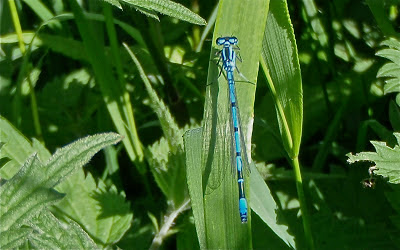After a few fine days with a drying and cool NE wind, it was back to rain brought on a south westerly wind but this morning, just before the rain set in, under cloudy, windy skies, the fine sight of a Red Kite gliding in circles over the river, with a kestrel closer to the ground, also gliding rather than hovering, covering the same ground.
Here are some fine weather views from the previous few days
on the Riverbank:
The wheat crop growing well in fields just across the river, with an old
Blackthorn hedgerow and oaks
A Brimstone Butterfly resting after some marathon flying,
looking like a pale leaf, fluttering along the river.
This butterfly needs Purging Buckthorn which
grows in scrub in neutral areas, or Alder Buckthorn which grows
in scrub in acidic areas.
AZURE damselfly male (Coenagrion puella) perching in the sun on river bank vegetation
AZURE damselfly female nearby on the river bank
Sunday 2nd June 2013 - a fine sunny morning with a NW breeze and grass wet with dew, strangely the river was higher than during early June last year - but the 2012 June floods were yet to come.
Large numbers of our local birds were very active on the riverside - it was good to hear the constant chatter of house sparrows (70) with juveniles joining the adults on their first exploration of the river - lining up along the fence, waiting to be fed whilst their parents collected insects in amongst the Blackthorn and deep amongst the Hawthorn blossom where insects were plentiful - at last, after a long cold spring, enough food for all. Blackbirds seen were adults, some singing whilst others collected food for young still in the nest, very late this year. (29)
The smell of Wild Garlic on the banks was not as potent as it had been, being replaced now with other more fragrant wild flowers. Robins (10) were singing and 'fly catching', some singing loudly in competition with the chiffchaffs in the oaks. Woodpigeons (17) were wing-flapping displaying and preparing nests, they will have several broods, nesting until late in the autumn. Blue tits (18) and great tits (8) were elusive as nesting means no singing or roaming far - they save energy by collecting food close to their nests.
Chaffinches were still singing however (6) and a single dunnock sang out from a shady tree root. Wrens (11) were singing, each in its own territory low along the river, nesting late as are most birds this year. The late spring has had huge advantages, late nesting coincides with a proliferation of insect species, feeding on late spring plants and flowers, the late blossoming of the hedgerow and thicket plants mean bountiful crops of berries and fruits later, unaffected by frost.
Nuthatches (4) however were quite early to nest and the youngsters were out and about, giving quiet contact calls, feeding on insects until the autumn brings (hopefully) a choice of nuts and they are again in competition with the Jays (2 seen today) and squirrels. A green woodpecker flew silently across - an adult visiting its nest does not draw attention to it. Goldfinches, just 2 were seen as they split up their flocks and keep quiet too.
Very faint calls above - a party of long-tailed tits,(6) juveniles not yet in their full adult plumage were foraging together in the Blackthorn - both these and the wrens, together with other ground and low-level nesting birds were all affected by the June floods last year - this year they will make up for the losses. A song thrush was busy under the cover of a hedge base, collecting food, definitely a late nester this year, whilst a great spotted woodpecker flew across from the trees. In the air just 10 starling appeared, 2 crows, a jackdaw and 3 magpies were seen. Noise above alerted me to a single herring gull over the river, trying to 'mob' a fine superior buzzard. The buzzard sailed away and 5 swifts were seen whizzing around directly overhead, collecting insects. Down on the river bank, a peaceful scene of a mallard pair dozing, safely sheltered from predators by the river bank vegetation and out of sight from predators on the wing under the overhanging branches. 2 more were heard, hidden from view (4).
Best of all were the visiting migrant warblers, the calling chiffchaffs (6), male blackcaps singing their beautiful songs from the willows and Hawthorn blossom (5), 2 willow warblers, a reed
warbler amongst the tall grasses, 2 garden warblers flying amongst the willows, identified by their song and the whitethroats (11) such characters!




No comments:
Post a Comment